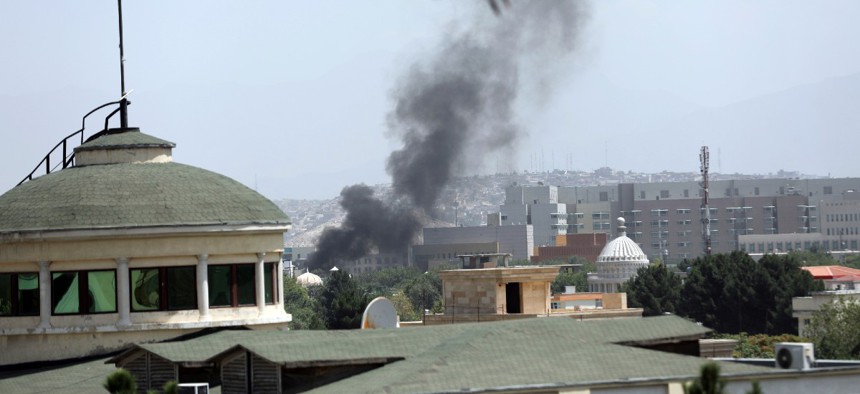DOD IG Issues Guidance for Removing Sensitive Tech and Data from Afghanistan

Smoke rises next to the U.S. Embassy in Kabul, Afghanistan Aug. 15. Rahmat Gul/AP
Service members’ records were mishandled during previous contingency operations. The watchdog suggested learning from the past.
The U.S. military must take deliberate steps to ensure that records are kept and sensitive data is protected or removed from the equipment it used in Afghanistan as it embarks on this ongoing, chaotic withdrawal from the country.
A management advisory published last week by the Defense Department’s Office of Inspector General intends to guide those involved in that work. In it, officials highlight existing policies and learnings from past oversight reviews of contingency operations that could be applied during the drawdown in Afghanistan.
DOD’s IG released its first report associated with the withdrawal of American forces and equipment from Afghanistan for this fiscal year in December. This report marks its second.
“[T]he purpose of the management advisory is to assist U.S. military, civilian, and contractor personnel responsible for the withdrawal of U.S. forces from Afghanistan with proper handling of equipment containing sensitive information and satisfying the requirements to retain administrative records,” a spokesperson from the office told Nextgov on Monday.
The advisory compiles “weaknesses” pinpointed across nine reports issued by the Government Accountability Office, DOD Office of Inspector General, Special Inspector General for Afghanistan Reconstruction, and Special Inspector General for Iraq Reconstruction between 2003 and 2020. It hones in on past implications of military-made moves involving poor recordkeeping and incorrectly removing sensitive data from controlled inventory items.
Officials point to Army Regulation 735‑5 and the 401st Army Field Support Brigade’s standard operating procedures for property accountability, which elaborate on how controlled inventory devices and items with hard drives should be properly handled. All data has to be cleared before they are returned and can be accepted by personnel on the Redistribution Property Assistance Team. An OIG report from 2014 showed, however, that some officials on that team then based at the Kandahar Airfield, Afghanistan did not make sure hard drives were wiped before accepting them.
“Units did not clear the sensitive data from four navigation systems and a counter radio‑controlled improvised explosive device system,” officials wrote.
Equipment with private information that must be saved and secured is also used in American military medical treatment facilities in Afghanistan. Such facilities have diagnostic medical devices that capture and store personally identifiable information and protected health information of U.S. military and civilian members. The IG report noted there’s room for improvement when it comes to how the military protects, disposes of, and rotates out such items. It also mentioned a few policies that direct such actions.
In choosing what to do with the equipment used by troops in Afghanistan, military and contract personnel must abide by existing guidance for retaining records about their contingency operations. Multiple procedures and policies that the Defense Department and its many components turn to in records management are listed as part of this review. They include the Department of the Army Pamphlet 25‑403, DOD Instruction 5015.02, and Chairman of the Joint Chiefs of Staff Instruction 5760.01A—among others.
“As of July 5, 2021, the U.S. military had transferred, disposed of, or retrograded nearly 90 percent of the billions of dollars of its equipment previously located across multiple bases in Afghanistan. This included equipment used by the military, along with equipment provided by the U.S. government to contractors in support of military operations,” officials wrote. “Maintaining equipment records for transfers, disposals, and retrograde for Afghanistan is critical.”
They detailed several examples of how DOD did not previously keep appropriate documentation regarding disposals or retrogrades of military equipment abroad. A DOD-OIG-crafted report from 2014, for example, revealed that the “Army did not properly account for $424.5 million of equipment deployed to Afghanistan from 2001 through 2013.”
Task Force Jesup was implemented by the military branch in 2014 to pave a trail toward accountability for $2.2 billion “worth of equipment lost in Afghanistan from 2006 to 2015,” officials noted. That task force sifted through heaps of records to reconstruct the various property transactions for thousands of missing pieces of equipment, which spanned handheld items to mine‑resistant, ambush‑protected vehicles. The project was able to account for more than $1 billion in items that were missing.
“However, after the August 2021 withdrawal of all U.S. forces from Afghanistan, the U.S. military will be physically unable to search for lost equipment on its various bases throughout Afghanistan. Instead, it will have to rely solely upon its paper and electronic records to search for equipment lost in Afghanistan,” officials noted. “Therefore, it is imperative that all commands and units responsible for property accountability, especially for the disposition of excess military equipment, retain their records within a property accountability system.”
The report further discusses how ineffective recordkeeping during past contingency operations resulted in missing personnel records—and ultimately put service members and veterans in unfortunate situations.
“The Army Center of Military History declared Operation Desert Storm as a ‘records disaster.’ The Army did not collect or preserve any records,” it said. “From 1993 through 1994, U.S. military personnel became sick with what is now referred to as the Gulf War Syndrome; however, there were no records at the time to validate their claims.”
Poor records collection and management practices during previous contingency operations also left the burden on some U.S. military personnel to prove their service, in order to receive veterans benefits for the time they served in combat zones or near toxins.
“The lessons from past oversight of contingency operations should be used to ensure better controls during the ongoing withdrawal from Afghanistan,” officials wrote.
NEXT STORY: Naps Don't Actually Relieve Sleep Deprivation






